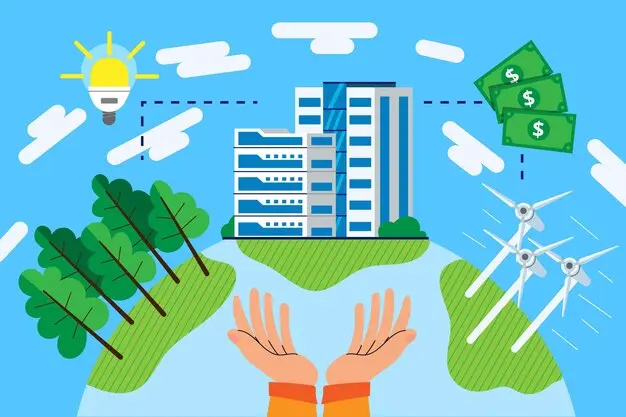In the face of growing environmental concerns and the urgent need to reduce our carbon footprint, the concept of sustainable living has gained significant traction. One of the most impactful ways we can contribute to this global effort is through our homes.
Energy-efficient housing, green building, eco-friendly housing, and environmentally friendly housing are not just buzzwords in the realm of sustainable development. They represent a profound shift in how we think about our homes, our energy usage, and our responsibility towards the environment.
As we delve into this topic, we’ll explore how energy conservation measures and efficient energy use in our homes can lead to significant reductions in power consumption and energy demand. We’ll also look at how energy-efficient design and construction can contribute to sustainable architecture and the creation of sustainable communities.
Whether you’re a newly married couple looking to set up your first home, a new homeowner exploring ways to make your house more energy-efficient, a young environmentalist passionate about sustainable living, or anyone interested in sustainable urban development, this blog post is for you.
Join us as we explore the role of energy efficiency in sustainable housing, and how it can help us achieve our global sustainability goals, reduce greenhouse gas emissions, and contribute to a healthier planet for future generations.
Key Takeaways:
- Energy-efficient housing plays a crucial role in sustainable living, contributing to environmental sustainability, cost savings, and improved quality of life.
- Key elements of energy-efficient housing include energy-efficient design and construction, energy-efficient appliances and systems, and proper insulation and ventilation.
- Green building and sustainable architecture are integral to energy-efficient housing, promoting the use of sustainable materials and design principles that reduce energy consumption.
- Energy-efficient housing contributes to sustainable urban development and the creation of sustainable communities.
- Energy regulations and standards encourage the construction of energy-efficient buildings and promote sustainable development.
- Energy-efficient housing can significantly reduce greenhouse gas emissions, helping to mitigate climate change.
- The future of energy-efficient housing looks promising, with growing demand and advances in technology making it increasingly affordable and practical.
- Homeowners can make their homes more energy-efficient through practical steps such as upgrading to energy-efficient appliances, improving insulation, using energy-efficient lighting, installing a programmable thermostat, and considering renewable energy sources.
Understanding Energy Efficiency
Energy efficiency is a concept that is often mentioned in discussions about climate change and sustainability, but what does it really mean? In simple terms, energy efficiency refers to the practice of using less energy to perform the same task, thereby reducing energy waste. In the context of housing, this means designing and building homes in a way that minimizes energy use without compromising on comfort or functionality.
Energy efficiency plays a pivotal role in sustainable housing. By reducing the amount of energy our homes consume, we can significantly cut down on our carbon emissions, contributing to environmental sustainability. But the benefits of energy-efficient housing extend beyond just the environment. Energy-efficient homes are often more comfortable to live in, with better temperature regulation and fewer drafts. They also result in lower energy bills, which can lead to substantial cost savings over time.
The Benefits of Energy-Efficient Housing
The advantages of energy-efficient housing are manifold. Let’s delve into some of the key benefits:
Cost Savings: Energy-efficient homes use less energy for heating, cooling, and electrical appliances, which can result in significant savings on utility bills. Over time, these savings can offset the initial investment required to implement energy-saving measures.
Environmental Impact: By reducing energy consumption, energy-efficient homes contribute to a decrease in greenhouse gas emissions, helping to mitigate the effects of climate change.
Comfort and Quality of Life: Energy-efficient homes often provide a more comfortable living environment. They maintain a more consistent indoor temperature and have fewer drafts. Energy-efficient appliances tend to operate more quietly, adding to the overall comfort.
Key Elements of Energy-Efficient Housing
Energy-efficient housing incorporates a variety of design elements, construction techniques, and technologies. Here are some key components:
Energy-Efficient Design and Construction: This includes elements like proper insulation, high-quality windows, and strategic building orientation to take advantage of natural light and heat.
Energy-Efficient Appliances and Systems: Energy-efficient appliances, such as refrigerators, washing machines, and HVAC systems, use less energy than their standard counterparts.
Insulation and Ventilation: Proper insulation and ventilation are crucial for maintaining a comfortable temperature in the home, reducing the need for heating and cooling.
Green Building and Sustainable Architecture
Green building, also known as sustainable architecture, is an approach to design and construction that minimizes the environmental impact of a building over its entire lifecycle. It involves the use of energy-efficient technologies, sustainable materials, and design principles that reduce energy consumption and promote environmental sustainability.
In the context of energy-efficient housing, green building plays a crucial role. It involves designing homes to maximize natural light, improve air quality, and promote efficient energy use. This can include everything from the strategic placement of windows to the use of energy-efficient appliances and renewable energy sources.
Sustainable architecture also involves considering the building’s impact on the local environment and community. This can include factors like the building’s location, its impact on local ecosystems, and the sustainability of the materials used in its construction.
Energy Conservation Measures in Housing
Energy conservation in housing involves implementing measures that reduce energy consumption and promote efficient energy use. Here are some key energy conservation measures that can be implemented in homes:
Energy-Saving Appliances: Using appliances that are designed to use less energy, such as Energy Star-rated appliances, can significantly reduce a home’s energy consumption.
Efficient Use of Lighting: This can involve using energy-efficient light bulbs, maximizing natural light, and using timers or sensors to ensure lights are only on when needed.
Heating and Cooling Systems: Energy-efficient heating and cooling systems can use significantly less energy than older, less efficient models. Additionally, maintaining a moderate temperature setting and using programmable thermostats can result in additional energy savings.
Sustainable Urban Development and Communities
Energy-efficient housing plays a crucial role in sustainable urban development and the creation of sustainable communities. By reducing energy consumption and greenhouse gas emissions, energy-efficient homes contribute to the overall sustainability of the communities they’re part of.
Sustainable communities are designed to be environmentally friendly, economically prosperous, and socially equitable. They prioritize sustainable development practices, including energy-efficient housing, to promote the well-being of their residents and the environment.
In the next sections, we’ll explore the role of energy regulations and standards in promoting energy-efficient housing, and how energy-efficient housing can help reduce greenhouse gas emissions. We’ll also look at the future of energy-efficient housing and provide practical tips for homeowners looking to improve the energy efficiency of their homes.
Energy Regulations and Standards
Energy regulations and standards play a crucial role in promoting energy-efficient housing. These guidelines, often set by government bodies, establish minimum requirements for energy efficiency in new construction and major renovations. They cover various aspects of a building’s design and construction, including insulation, heating and cooling systems, lighting, and appliances.
For example, energy standards may specify the minimum level of insulation required in a home, or they may require that certain types of energy-efficient appliances be used. By setting these standards, governments can encourage the construction of energy-efficient buildings and promote sustainable development.
In addition to regulations and standards, many governments also offer incentives to encourage energy-efficient construction. These can include tax credits, rebates, and grants for homeowners who invest in energy-efficient upgrades.
Reducing Greenhouse Gas Emissions through Energy-Efficient Housing
One of the most significant benefits of energy-efficient housing is its potential to reduce greenhouse gas emissions. Buildings account for a substantial portion of global greenhouse gas emissions, primarily due to the use of fossil fuels for heating, cooling, and electricity.
By reducing the amount of energy a home uses, we can significantly reduce these emissions. This not only helps to mitigate climate change but also contributes to cleaner air and a healthier environment.
Energy-efficient homes also contribute to the reduction of CO2 emissions by reducing the demand for electricity from power plants. When less electricity is needed, fewer fossil fuels are burned, resulting in lower emissions.
The Future of Energy-Efficient Housing
The future of energy-efficient housing looks promising. As awareness of climate change and the need for sustainable living continues to grow, so does the demand for energy-efficient homes. Advances in technology are making it increasingly affordable and practical to build homes that are highly energy-efficient.
In the future, we can expect to see more homes featuring advanced energy-saving technologies, such as smart thermostats and appliances, solar panels, and high-efficiency heating and cooling systems. We can also expect to see more widespread adoption of green building practices and sustainable architecture.
How to Make Your Home More Energy Efficient
If you’re a homeowner looking to make your home more energy-efficient, there are many practical steps you can take. Here are a few suggestions:
Upgrade to Energy-Efficient Appliances: If your home appliances are old, consider replacing them with Energy Star-rated models that use less energy.
Improve Insulation: Proper insulation can significantly reduce the amount of energy needed for heating and cooling.
Use Energy-Efficient Lighting: Replace traditional light bulbs with energy-efficient LEDs, and make the most of natural light.
Install a Programmable Thermostat: This allows you to automatically adjust the temperature when you’re not home, saving energy.
Consider Renewable Energy Sources: If possible, consider installing solar panels or using other renewable energy sources to power your home.
Conclusion
The role of energy efficiency in sustainable housing is crucial. It not only helps homeowners save money on energy bills but also contributes to environmental sustainability and the fight against climate change. By making our homes more energy-efficient, we can all play a part in creating a more sustainable future. Whether you’re a new homeowner, a sustainable living enthusiast, or simply someone looking to reduce your carbon footprint, investing in energy-efficient housing is a step in the right direction.
Frequently Asked Questions (FAQs)
-
What is energy-efficient housing?
Energy-efficient housing refers to homes designed and built to minimize energy use, thereby reducing energy waste and contributing to environmental sustainability.
-
What are the benefits of energy-efficient housing?
Energy-efficient housing offers several benefits, including cost savings on utility bills, reduced environmental impact, and improved comfort and quality of life.
-
What are some key elements of energy-efficient housing?
Key elements of energy-efficient housing include energy-efficient design and construction, energy-efficient appliances and systems, and proper insulation and ventilation.
-
How does energy-efficient housing contribute to sustainable communities?
By reducing energy consumption and greenhouse gas emissions, energy-efficient homes contribute to the overall sustainability of the communities they’re part of, promoting environmental, economic, and social well-being.
-
How can I make my home more energy-efficient?
You can make your home more energy-efficient by upgrading to energy-efficient appliances, improving insulation, using energy-efficient lighting, installing a programmable thermostat, and considering renewable energy sources.

